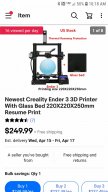- Messages
- 374
- Reaction score
- 400
- Location
- Brooksville, FL
- Arrma RC's
- BigRock 4x4
- Kraton 6s
- Nero
- Outcast 6s
What’s the best 3D printer under 350... looking to have a fairly large print size and easy to setup and easy to work with as it would be my first printer. I was looking at the creality ender 5 as it’s on sale for 330 right now but the sale ends before I would be ready to buy.


